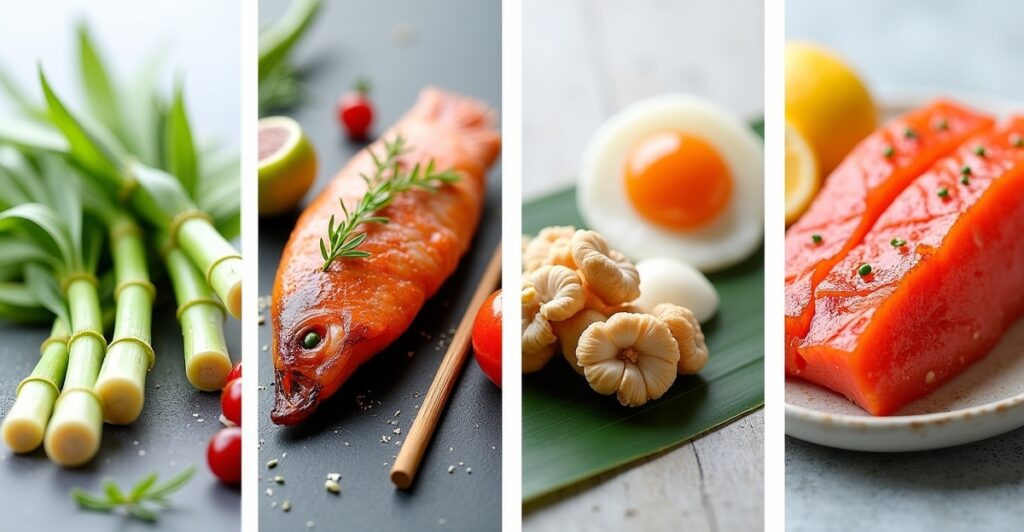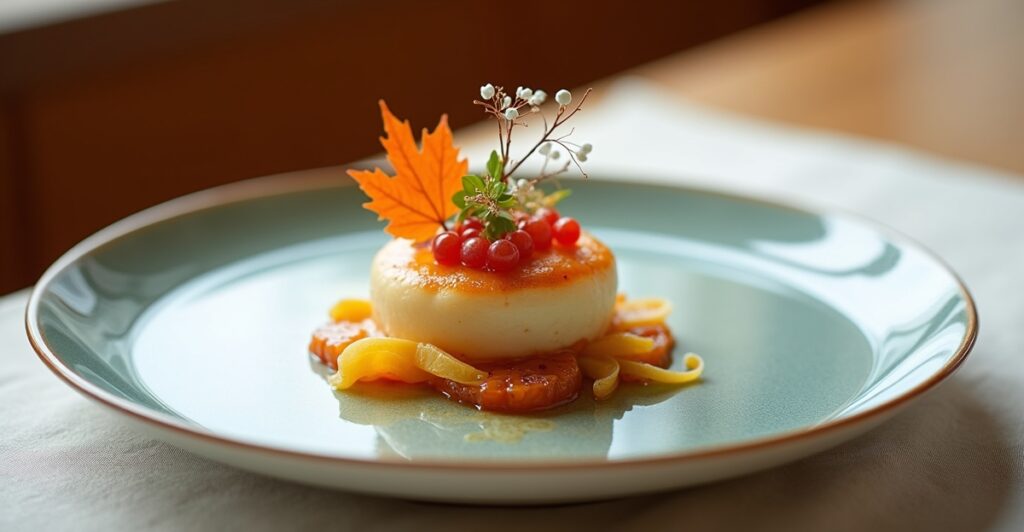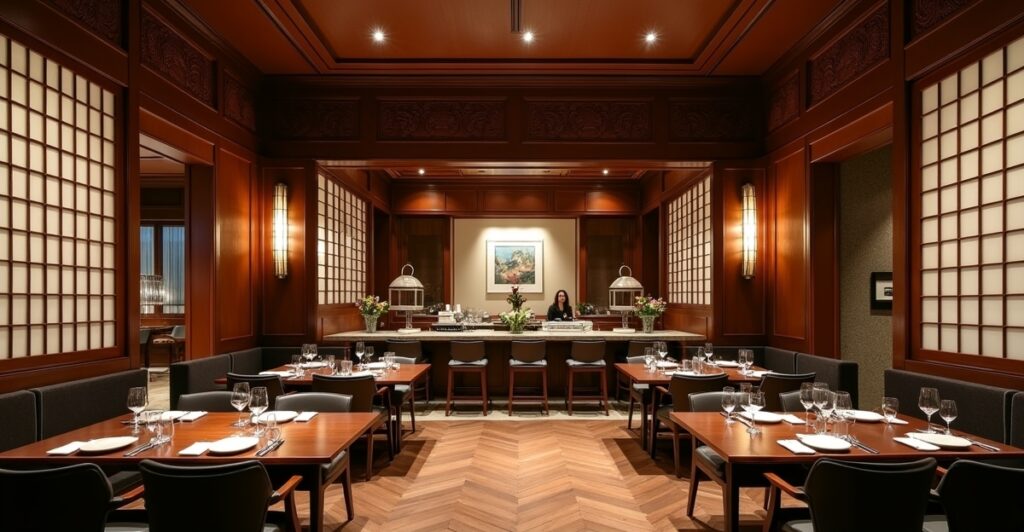By The Culinary Experts at Ginza Honoka
Shun no Mono (旬の物) represents the heart of Japanese cuisine—the philosophy of celebrating ingredients at their absolute peak of seasonality. This fundamental principle of washoku (traditional Japanese food) goes far beyond mere ingredient selection; it embodies a profound respect for nature’s rhythms and the pursuit of culinary perfection that defines Japanese fine dining.
In the refined world of Japanese cuisine, master chefs dedicate their lives to understanding when each ingredient reaches its moment of shun—that fleeting period when flavor, texture, and nutritional value achieve perfect harmony. This reverence for seasonality transforms dining from mere sustenance into an artistic expression that connects diners with the natural world and the changing seasons.
At Ginza Honoka, we honor this timeless tradition, crafting each dish to showcase ingredients precisely when they offer their most exquisite expression. Our commitment to shun no mono ensures that every dining experience reflects the authentic spirit of Japanese food and the mastery that defines true Japanese fine dining.
The Heart of Washoku: Understanding the Philosophy of Shun no Mono
The shun no mono meaning extends far deeper than seasonal availability—it represents a cornerstone of washoku philosophy that reflects the Japanese cultural values of harmony, respect, and mindful appreciation. This Japanese culinary philosophy recognizes three distinct phases of ingredient seasonality, each offering unique culinary experiences:
The Three Phases of Seasonal Ingredients:
- Hashiri (走り): The “first” or “running” phase when ingredients first appear, prized for their rarity and delicate, youthful characteristics
- Shun (旬): The peak season when ingredients achieve perfect maturity, optimal flavor, and nutritional density
- Nagori (名残): The “farewell” phase as the season wanes, offering deeper, more concentrated flavors before the ingredient disappears
This sophisticated understanding of temporal flavor development reflects the kisetsu-kan (seasonal sense)—an intuitive awareness of nature’s cycles that permeates Japanese culture. Master chefs spend years developing this sensitivity, learning to identify the subtle differences between hashiri’s bright promise, shun’s perfect balance, and nagori’s concentrated essence.
More Than Just Food: A Connection to Nature
The philosophy of shun embodies the Japanese concept of respect for nature and the Buddhist principle of impermanence. Each ingredient’s brief moment of perfection reminds us to appreciate fleeting beauty—whether it’s the tender shoots of spring bamboo or the rich, fatty flesh of winter yellowtail.
This deep connection transforms cooking from technical skill into spiritual practice. At Ginza Honoka, our chefs approach each ingredient with gratitude and reverence, understanding that their role is not to dominate nature but to reveal its inherent perfection through mindful preparation and presentation.
A Calendar of Flavors: Iconic Seasonal Ingredients in Japan
Japan’s distinct seasons create a natural calendar of seasonal Japanese ingredients, each offering unique characteristics that master chefs celebrate through refined techniques and artistic presentation. Understanding these seasonal transitions allows discerning diners to fully appreciate the craftsmanship behind each dish.

The cyclical nature of seasonal Japanese ingredients creates anticipation and celebration. At Ginza Honoka, we carefully time our menu changes to capture each ingredient’s shun, ensuring our guests experience the authentic rhythm of Japan’s culinary calendar.
Spring: The Promise of New Beginnings
Spring ingredients Japan celebrate renewal and delicate flavors that awaken the palate after winter’s hearty fare. The season’s takenoko (bamboo shoots) arrive with tender sweetness and subtle mineral notes, requiring immediate preparation to preserve their ephemeral perfection. Master chefs at Ginza Honoka prepare these treasured shoots within hours of harvest, often serving them simply boiled with a touch of rice bran to highlight their natural sweetness.
Madai (cherry snapper) reaches its peak during cherry blossom season, its flesh achieving perfect firmness and subtle sweetness that pairs beautifully with spring’s gentle flavors. The timing is so precise that chefs speak of “sakura-madai”—snapper caught during the brief cherry blossom period.
Sansai (wild mountain vegetables) like zenmai (royal fern), kogomi (fiddlehead fern), and fukinotou (butterbur sprouts) offer complex, slightly bitter flavors that cleanse the palate and prepare the body for spring’s energy. These foraged treasures require expert knowledge to identify, harvest, and prepare safely.
Summer: Lightness and Refreshment
Summer’s intense heat demands ayu (sweetfish), whose cucumber-like aroma and clean taste embody the season’s need for cooling foods. These river fish feed on algae, developing their characteristic sweetness and delicate texture. Master chefs grill them whole over charcoal, often serving them with bitter tade (water pepper) to balance their sweetness.
Unagi (eel) provides essential stamina during summer’s energy-sapping heat. The tradition of eating unagi on doyo no ushi no hi (the day of the ox during summer’s peak) reflects deep cultural wisdom about seasonal nutrition. At Ginza Honoka, we prepare unagi using traditional kabayaki techniques, grilling over binchotan charcoal to achieve the perfect balance of crispy skin and tender flesh.
Summer vegetables like eggplant, cucumber, and tomatoes reach their peak, offering hydration and cooling properties essential for the season’s challenges.
Autumn: The Harvest’s Rich Bounty
Autumn brings matsutake (pine mushrooms), perhaps Japan’s most prized autumn Japanese food. These aromatic fungi develop their distinctive spicy-sweet fragrance only in specific pine forests, making them extraordinarily rare and valuable. Their season is brief—sometimes lasting only weeks—requiring immediate preparation to capture their ephemeral essence.
Sanma (Pacific saury) arrives fat-rich and flavorful, their silver bodies gleaming with the oils that will sustain them through winter. Grilled simply with salt and served with grated daikon and bitter orange, sanma represents autumn’s abundance and the approaching need for warming foods.
Kuri (chestnuts) provide sweetness and substance, often prepared as kurigohan (chestnut rice) or incorporated into delicate wagashi sweets that celebrate the season’s golden beauty.
Winter: Comfort and Delicacy
Winter’s harsh conditions produce some of Japan’s most prized ingredients. Fugu (pufferfish) reaches its peak during the coldest months, its flesh achieving a unique firm texture and subtle sweetness that commands reverence and expertise. Licensed chefs spend years learning to prepare this delicacy safely, transforming potential danger into transcendent dining experiences.
Buri (yellowtail) develops rich, fatty flesh during winter migration, providing the warming calories needed for cold weather. The progression from summer’s lean hamachi to winter’s rich buri illustrates nature’s perfect timing.
Winter kaki (oysters) achieve their creamiest texture and sweetest flavor, often served raw or lightly cooked to preserve their oceanic essence and mineral complexity.
The Culinary Canvas: Shun no Mono in Japanese Fine Dining
The philosophy of shun no mono reaches its highest expression in Japanese fine dining, where master chefs transform seasonal ingredients into artworks that engage all senses. This culinary artistry requires not only technical skill but deep understanding of each ingredient’s perfect moment and the cultural significance of seasonal transitions.
In establishments like Ginza Honoka, every dish serves as a meditation on seasonality, with Japanese presentation that honors both the ingredient’s natural beauty and the season’s aesthetic character. The chef’s role transcends cooking—they become interpreters of nature’s subtle language, translating seasonal messages into culinary poetry.
Kaiseki: A Seasonal Symphony on a Plate
The kaiseki multi-course meal structure represents the ultimate expression of shun no mono, with each course carefully orchestrated to create a progression that mirrors the season’s natural rhythm. Seasonal kaiseki begins with the lightest, most delicate flavors and gradually builds complexity, allowing diners to experience the full spectrum of seasonal ingredients in perfect harmony.

A spring kaiseki might begin with tender bamboo shoot soup, progress through wild mountain vegetables and cherry snapper sashimi, and conclude with a delicate sweet featuring cherry blossoms. Each transition reflects the season’s natural progression, creating a dining experience that connects guests with nature’s rhythms.
Kaiseki courses follow traditional structures—sakizuke (appetizer), suimono (clear soup), mukōzuke (sashimi), yakimono (grilled dish)—but their contents change dramatically with the seasons, ensuring that no two kaiseki experiences are identical.
The Chef’s Art: Sourcing, Crafting, and Presenting Shun
Master chefs develop relationships with specific suppliers, farmers, and fishermen to ensure access to ingredients at their peak. This network requires years to establish and constant communication to time deliveries perfectly. At Ginza Honoka, our chefs visit markets before dawn, selecting ingredients by touch, smell, and visual cues that reveal each item’s readiness.
Japanese chef techniques evolved specifically to highlight each ingredient’s shun characteristics. Spring bamboo shoots receive minimal preparation to preserve their tender sweetness, while autumn mushrooms might be paired with subtle broths that enhance their earthy complexity. The chef’s expertise lies in knowing when to intervene and when to step back, allowing the ingredient’s natural perfection to shine.
Food presentation Japan requires understanding each ingredient’s optimal preparation method—whether the clean cuts that reveal perfect fish flesh or the gentle steaming that preserves vegetable integrity. Behind-the-scenes at Ginza Honoka, our chefs test multiple preparation methods for each seasonal ingredient, selecting techniques that best express their shun characteristics.
Beyond the Plate: Seasonal Aesthetics
Seasonal consciousness extends to every aspect of presentation, including Japanese tableware selection, garnish choices, and even the timing of service. Seasonal garnishes might include a single cherry blossom in spring, a maple leaf in autumn, or a delicate pine needle in winter—each chosen to reinforce the seasonal message.

The principle of yohaku no bi (the beauty of empty space) guides plating decisions, with chefs using negative space to create visual breathing room that allows each element to be appreciated fully. Seasonal dishware—perhaps earth-toned ceramics for autumn or cool blue porcelain for summer—reinforces the temporal connection.
This attention to aesthetic detail transforms dining into a multisensory experience where visual beauty, aromatic complexity, textural variety, and flavor perfection combine to create lasting memories.
Experiencing Shun no Mono: Tips for the Discerning Diner
Experiencing Japanese food at its highest level requires understanding how to identify and appreciate shun no mono principles. Appreciating seasonal ingredients begins with awareness—notice menu descriptions that emphasize timing (“first of the season,” “peak autumn,” “winter’s finest”) and preparations that highlight rather than mask natural flavors.
Japanese restaurant tips for discerning diners include trusting the chef’s seasonal selections, asking about ingredient sourcing, and remaining open to unfamiliar items that might be at their seasonal peak. The best experiences often come from surrendering control and allowing expert chefs to guide the seasonal journey.
How to identify shun no mono in practice involves observing preparation techniques—seasonal ingredients often receive minimal manipulation, allowing their natural characteristics to dominate. Look for dishes where the ingredient is the star rather than part of complex combinations.
Timing visits to coincide with specific seasons enhances the experience. Spring visits offer delicate flavors and renewal energy, summer provides cooling refreshment, autumn delivers rich complexity, and winter brings warming comfort and rare delicacies.
Conclusion: Embracing the Ever-Changing Palette
The philosophy of shun no mono represents more than culinary technique—it embodies a way of living that honors natural rhythms and finds beauty in impermanence. This culinary tradition connects modern diners with ancient wisdom, reminding us that the most profound pleasures often come from patient attention to nature’s subtle gifts.

At Ginza Honoka, our commitment to shun no mono ensures that each visit offers a unique window into the season’s perfect expressions. As we look toward the future of Japanese cuisine, this timeless principle continues to guide innovation while preserving the essential connection between food, nature, and cultural identity.
The ever-changing palette of seasonal ingredients keeps Japanese cuisine eternally fresh and relevant, offering infinite possibilities for discovery and appreciation. By embracing shun no mono, we participate in a tradition that celebrates both the abundance and the ephemeral nature of seasonal perfection.
Frequently Asked Questions (FAQ) about Seasonality in Japanese Cuisine
What does Shun no Mono mean?
Shun no Mono (旬の物) literally translates to “things in season” and refers to the Japanese culinary philosophy of using ingredients at their absolute peak of seasonality when they offer optimal flavor, texture, and nutritional value.
Why is seasonality important in Japanese food?
Seasonality in Japanese food reflects the cultural values of harmony with nature, respect for natural rhythms, and the pursuit of perfection. It ensures optimal flavor and nutrition while connecting diners to the natural world and traditional wisdom.
What are some famous seasonal Japanese ingredients?
Famous seasonal ingredients include spring takenoko (bamboo shoots) and cherry snapper, summer ayu (sweetfish) and unagi (eel), autumn matsutake mushrooms and sanma (Pacific saury), and winter fugu (pufferfish) and rich yellowtail.
How do Japanese chefs use seasonal ingredients?
Japanese chefs use minimal preparation techniques that highlight rather than mask seasonal ingredients’ natural characteristics. They time sourcing precisely and adjust cooking methods to express each ingredient’s peak qualities.
What is hashiri, shun, and nagori?
These terms describe the three phases of seasonal ingredients: hashiri (first appearance, prized for rarity), shun (peak season with optimal flavor), and nagori (farewell phase with concentrated flavors before the season ends).
Experience the authentic philosophy of Shun no Mono at [Ginza Honoka](the overarching philosophy of Washoku), where our master chefs honor each season’s perfect expressions through the multi-course structure of a traditional Kaiseki meal and the aesthetic principles of Moritsuke. Discover how this UNESCO Intangible Cultural Heritage designation continues to inspire culinary excellence. Learn more about deeper insights into Japan’s diverse culinary traditions through the Japan National Tourism Organization.
